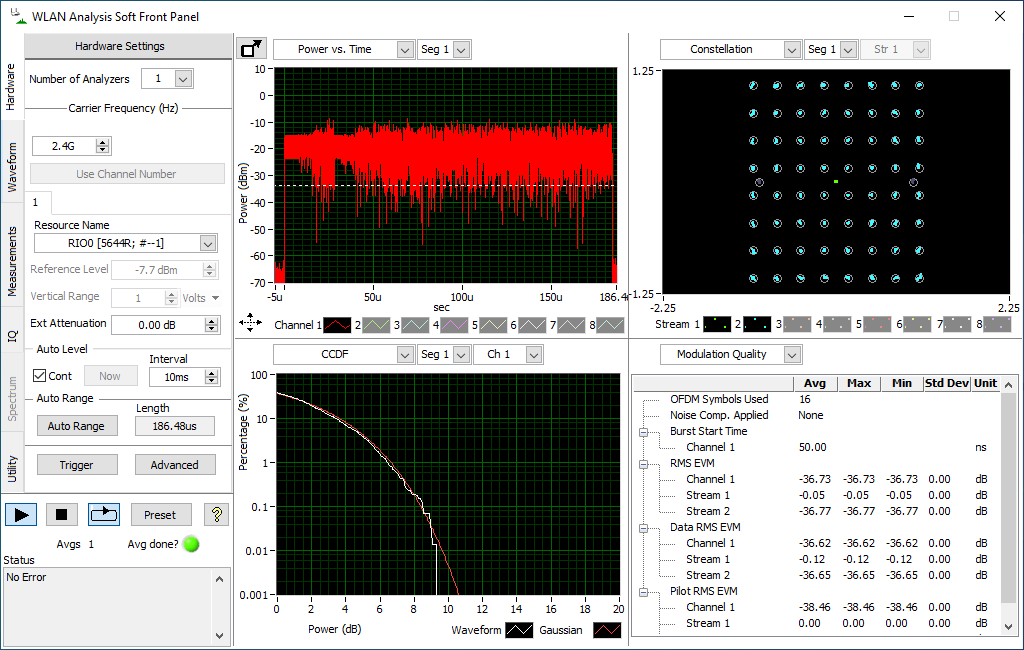1. 概述
SDR-B1是正旗通信推出的软件无线电平台,采用Xilinx Zynq XC7Z045 FPGA及ADI AD9363无线收发芯片,本文给出了使用SDR-B1进行WLAN MIMO发射测试的过程。
2. 测试仪表
- NI PCIe-5644R
- GWINSTEK GPD-3303S
3. 测试软件
- Matlab R2024a(AMD SoC Support from SoC Blockset)
- NI WLAN Analysis Toolkit
4. 测试设置
按照如下的方式进行连接,PC1与SDR-B1通过网线相连接,PC1的IP地址设置为192.168.2.30,用于运行Matlab程序,向SDR-B1发送波形;SDR-B1的IP地址设置为192.168.2.55,并烧写我司提供的专用测试固件;PC2运行NI WLAN Analysis Toolkit,并与NI PCIe-5644R通过雷电线连接。
5. 测试过程
(1) 为SDR-B1上电,启动完成后,输入用户名与密码(均为root),输入以下命令:
ifconfig eth0 192.168.2.55
(2) 使用Matlab打开wlan_tx_ht.m,并在最后一行处设置断点,如下图
(3) 点击运行,可以在命令窗口中观察到如下信息:
Generating WLAN transmit waveform:
## Establishing connection to hardware. This process can take several seconds.
## Waveform transmission has started successfully and will repeat indefinitely.
## Call the release method to stop the transmission.
此时可以在NI WLAN Analysis Toolkit中观察到对应的分析结果,如下图
可以看到,仪器已经识别出来此时的发射信号是双流信号,也就是MIMO,并且当前是第一条流。
(4) 将PCIe-5644R连接至SDR-B1的TX2端口,仪器可以识别到此时是第二条流的信号,如下图,软件中使用了不同的颜色代表两条流的分析结果。

(5) 在Matlab中点击继续,停止SDR-B1的发射,测试结束。
6. 测试代码
wlan_tx_ht.m的内容如下:
clear;
cfgPHY = wlanHTConfig(MCS=15);
msduLength = 2304; % MSDU length in bytes
numMSDUs = 10;
txData = zeros(1,msduLength);
for i = 1:msduLength
txData(i) = randi([0 255]);
end
data = zeros(0,1);
for i=0:numMSDUs-1
frameBody = txData;
% Create MAC frame configuration object and configure sequence number
cfgMAC = wlanMACFrameConfig(FrameType='Data',FrameFormat="HT-Mixed",MPDUAggregation=true,SequenceNumber=i);
% Generate MPDU
[psdu, lengthMPDU]= wlanMACFrame(frameBody,cfgMAC,cfgPHY,OutputFormat='bits');
% Concatenate PSDUs for waveform generation
data = [data; psdu]; %#ok
end
HTcfg = wlanHTConfig; % Create packet configuration
HTcfg.MCS = 15; % Modulation: 64QAM Rate: 5/6
HTcfg.NumTransmitAntennas = 2; % Number of transmit antenna
HTcfg.NumSpaceTimeStreams = 2;
chanBW = HTcfg.ChannelBandwidth;
HTcfg.PSDULength = lengthMPDU; % Set the PSDU length
scramblerInitialization = randi([1 127],numMSDUs,1);
osf = 1.5;
sampleRate = wlanSampleRate(HTcfg); % Nominal sample rate in Hz
txWaveform = wlanWaveformGenerator(data,HTcfg, ...
NumPackets=numMSDUs,IdleTime=20e-6, ...
ScramblerInitialization=scramblerInitialization,...
OversamplingFactor=osf);
% Transmitter properties
sdrTransmitter = sdrtx('AD936x');
sdrTransmitter.IPAddress = '192.168.2.55';
sdrTransmitter.ChannelMapping = [1,2];
sdrTransmitter.BasebandSampleRate = sampleRate*osf;
sdrTransmitter.CenterFrequency = 2.4e9;
sdrTransmitter.Gain = -10;
fprintf('\nGenerating WLAN transmit waveform:\n')
% Scale the normalized signal to avoid saturation of RF stages
powerScaleFactor = 0.8;
txWaveform1 = txWaveform(:,1);
txWaveform2 = txWaveform(:,2);
txWaveform1 = txWaveform1.*(1/max(abs(txWaveform1))*powerScaleFactor);
txWaveform2 = txWaveform2.*(1/max(abs(txWaveform2))*powerScaleFactor);
% Transmit RF waveform
transmitRepeat(sdrTransmitter, [txWaveform1, txWaveform2]);
release(sdrTransmitter);


